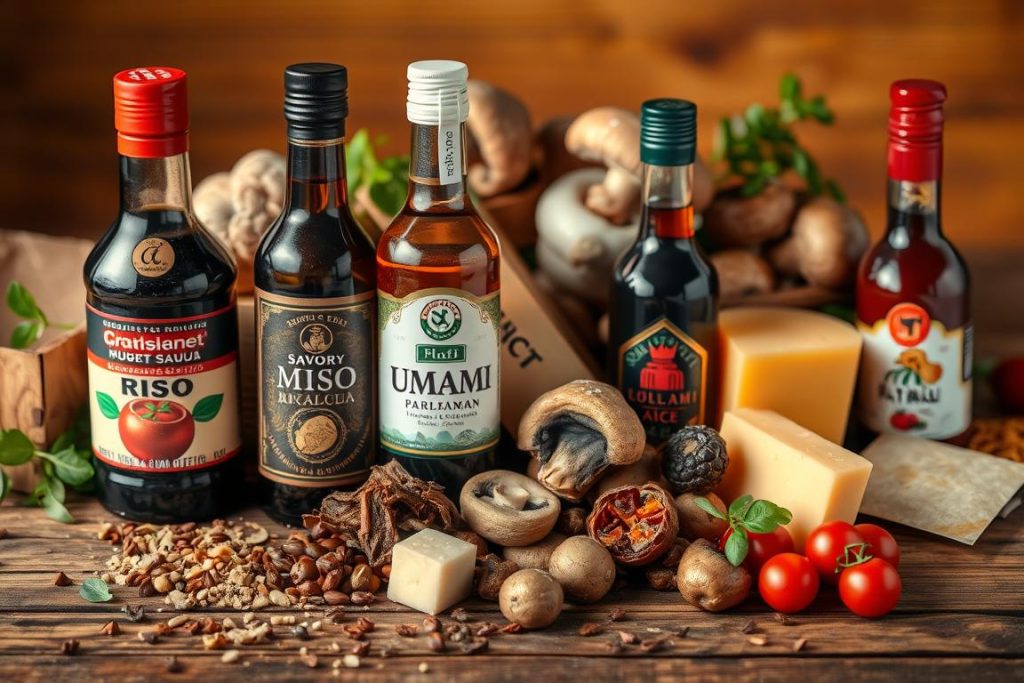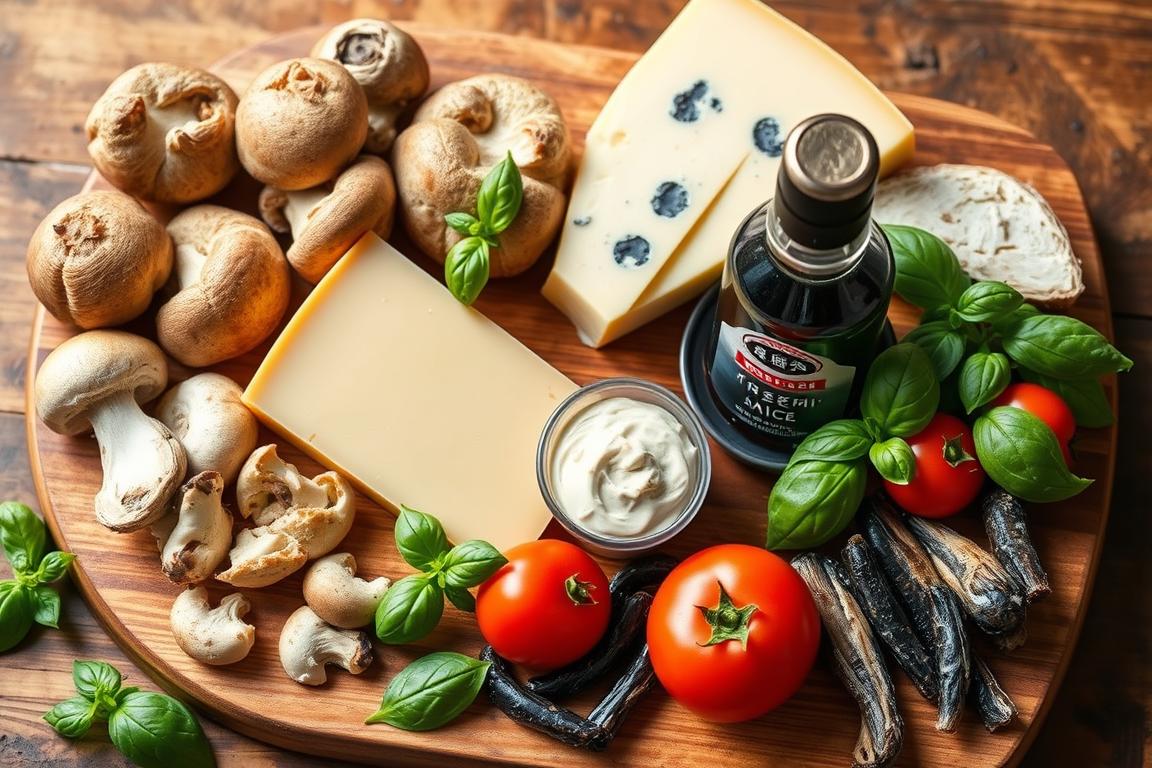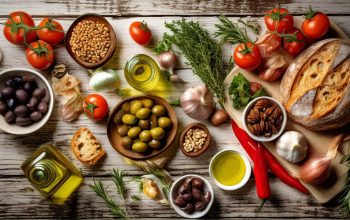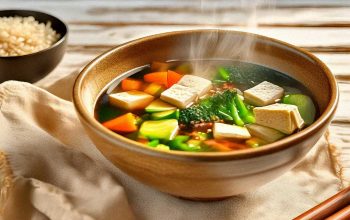Discover how to make your meals more flavorful and satisfying by exploring umami. Known as the fifth basic taste, umami adds a savory, mouth-watering taste to dishes. This guide will cover the science of umami, its origins, and the best ingredients to enhance your cooking.
Umami comes from glutamates and nucleotides found in foods. These interact with our taste receptors, creating a rich flavor. By using the right ingredients, you can make your meals more complex and enjoyable.
This article will show you how to use ingredients like aged cheeses, fermented foods, seafood, and meat to boost your cooking. Learn how to unlock new flavors in your dishes. Whether you’re an experienced chef or just starting, you’ll find valuable tips here.
What is Umami?
Umami is a unique taste often described as savory or meaty. It was first found in 1908 by Japanese chemist Kikunae Ikeda. He discovered that glutamate is the key compound behind this taste.
Definition and Origins
The term “umami” comes from Japanese, where “umai” means “delicious” and “mi” means “taste.” Ikeda found that umami is different from the other four tastes: sweet, sour, salty, and bitter. Foods rich in glutamate, like aged cheeses and mushrooms, are known for their umami.
Scientific Basis of Umami
Umami’s science is about how our taste receptors work with glutamate. Glutamate, a natural amino acid, connects with special receptors on our tongues. This creates the savory taste we know as umami. That’s why foods with lots of glutamate, like MSG, make dishes taste more savory.
Discovering the Five Basic Tastes
- Sweet: Detected by receptors for sugars and other carbohydrates
- Sour: Detected by receptors for acids, like those found in citrus fruits
- Salty: Detected by receptors for sodium and other mineral salts
- Bitter: Detected by receptors that warn of potentially toxic compounds
- Umami: Detected by receptors that respond to amino acids, like glutamate
Learning about these five basic tastes helps us enjoy the complex flavors in food.
Key Umami Ingredients
Mastering the right ingredients is key to enhancing umami flavor in your dishes. Mushrooms, tomatoes, and aged cheeses are top choices for a strong umami taste. Let’s dive into how these ingredients can boost your dishes’ flavor.
Mushrooms
Mushrooms are a goldmine of umami. From shiitake to portobello, they’re packed with glutamates that excite our taste buds. Cooking mushrooms in various ways releases their savory goodness, making dishes like pasta and vegetarian meals more flavorful.
Tomatoes
Tomatoes add a burst of umami flavor to any dish. Whether dried, roasted, or in sauce, their amino acids and glutamates create a savory taste. Combining tomatoes with aged cheeses or anchovies brings out a perfect umami balance.
Aged Cheeses
As cheeses like Parmesan, Pecorino Romano, and Manchego age, they become more umami-rich. Grated over pasta, mixed into sauces, or enjoyed alone, they add depth and complexity to any meal.
By using these umami powerhouses in your cooking, you open up a world of savory flavors. Try different combinations and cooking methods to see how mushrooms, tomatoes, and aged cheeses can take your dishes to new umami heights.
Fermented Foods and Umami
Fermentation brings out the unique umami flavors that make dishes special. From soy sauce to miso paste, fermented foods are full of umami. We’ll look at how to use these ingredients to add depth to your meals.
Soy Sauce and Tamari
Soy sauce and tamari come from fermented soybeans. They’re rich in umami. A little soy sauce or tamari can make any dish more savory.
Miso Paste
Miso is a Japanese seasoning made from fermented soybeans. It’s full of umami. You can use it in soups, sauces, and even baked goods. It’s great with vegetables, proteins, and grains.
Fermented Vegetables
Fermented vegetables are full of umami. Think sauerkraut, kimchi, pickles, and garlic. They add flavor to salads, sandwiches, and more.
“Fermentation unlocks a whole new world of flavor, transforming simple ingredients into complex, umami-packed delights.”
Seafoods That Pack Umami
The ocean is full of ingredients with rich, savory flavors. You’ll find everything from salty anchovies to tender mackerel and nutritious seaweed. These seafood treasures can add a delicious umami kick to your cooking.
Anchovies: Tiny Titans of Umami
Anchovies are small but mighty in flavor. They add a deep, savory taste to sauces, dressings, and even baked goods. These tiny fish are key in many Mediterranean and Italian dishes, bringing out complex flavors.
Mackerel: A Robust, Umami-Packed Fish
Mackerel is a fish full of umami. It has a rich, savory taste that goes well with strong flavors like garlic and ginger. Whether grilled, baked, or smoked, mackerel brings a unique briny flavor to dishes.
Seaweed: The Umami-Rich Superfood
Seaweed is a goldmine of umami flavors. From the nutty nori to the briny wakame, there’s a variety of umami-rich seaweed to try. Adding seaweed to soups, salads, and sauces can add a unique, earthy-sweet umami taste.
| Seafood | Umami Contribution | Culinary Uses |
|---|---|---|
| Anchovies | Intense, briny savory flavor | Sauces, dressings, baked goods |
| Mackerel | Rich, robust umami taste | Grilled, baked, or smoked dishes |
| Seaweed | Earthy-sweet umami essence | Soups, salads, sauces |
Using these seafood ingredients can take your cooking to the next level. Try them out to add more flavor and satisfy your taste buds.
“The ocean is a treasure trove of ingredients that brim with savory, umami-rich flavors.”
The Role of Broths and Stocks
Broths and stocks are key to getting that umami taste in your food. They add depth and complexity to dishes, making them stand out. This is what makes great food truly special.
Homemade Bone Broth
Homemade bone broth is a powerhouse of umami. It’s made by simmering bones, veggies, and herbs for hours. This process pulls out lots of minerals, collagen, and amino acids, creating a rich, savory broth.
The broth’s gelatin-like texture also makes soups, stews, and sauces feel velvety. It’s a game-changer for any dish.
- Use a mix of beef, chicken, or pork bones for the best flavor.
- Roasting the bones first adds a caramelized taste.
- Adding onions, garlic, and apple cider vinegar boosts the umami even more.
Vegetable Stock Varieties
Vegetable stocks are perfect for those who follow a plant-based diet or want a lighter option. By simmering various veggies, herbs, and spices, you can make brothy stocks. These are great for soups, risottos, and more.
- Roasting the veggies before simmering enhances their umami flavor.
- Adding mushrooms, tomatoes, and soy sauce gives an extra savory kick.
- Try different veggie mixes to find your favorite.
Whether you love the meaty taste of bone broth or the plant-based charm of vegetable stock, these umami-rich liquids are vital. They help make your meals flavorful and satisfying.
Umami-Rich Meats and Poultry
Certain meats and poultry can really boost the umami in your dishes. Aged beef and dark meat chicken are great examples. They add deep, satisfying flavors to your meals.
Beef and Pork Cuts
For a beefy umami taste, try ribeye, chuck roast, and short ribs. These cuts have lots of glutamates. When you sear or roast them, the flavors explode.
Pork shoulder and belly are also rich in umami. They add depth and richness to your dishes.
Dark Meat Chicken
Dark meat chicken, like thighs and wings, packs a big umami punch. It has more glutamate-rich proteins and fats. This makes the flavor more savory.
Using dark meat chicken in stews, braises, and roasted dishes can enhance your meals’ umami.
| Umami-Rich Meat Cut | Umami Compounds | Best Cooking Methods |
|---|---|---|
| Beef Ribeye | Glutamate, Inosinate | Searing, Roasting |
| Pork Shoulder | Glutamate, Inosinate | Braising, Slow Cooking |
| Chicken Thighs | Glutamate, Inosinate | Baking, Grilling |
Adding these umami-rich meats and poultry to your cooking can make your dishes more savory. You’ll create meals that are truly satisfying and leave you wanting more.
Utilizing Umami in Vegetables
Vegetables can be amazing sources of umami, the savory fifth taste. When prepared right, they can make vegetarian and vegan dishes taste incredible. This is because of the natural umami compounds in plant-based ingredients.
Roasted Veggies
Roasting vegetables is a simple yet effective way to boost their umami taste. When vegetables are roasted, their sugars caramelize, creating a deep, savory flavor. This flavor complements the umami already in the veggies.
Try roasting mushrooms, tomatoes, eggplant, or even Brussels sprouts. They all become even more flavorful.
Sauces and Condiments
Using umami-rich sauces and condiments can also transform plant-based dishes. Soy sauce, miso paste, Worcestershire sauce, and tomato paste are all great for adding savory flavor. Use them to make marinades, dressings, or dipping sauces.
These can enhance the taste of your roasted or sautéed vegetables.
| Umami-Boosting Ingredients | Uses |
|---|---|
| Soy sauce | Marinades, dressings, dips |
| Miso paste | Sauces, soups, glazes |
| Tomato paste | Sauces, stews, braises |
| Worcestershire sauce | Marinades, dressings, condiments |
Learning to use umami in vegetables opens up a world of flavor. It lets you create delicious plant-based dishes that everyone will love.
Cooking Techniques to Enhance Umami
To bring out the savory taste of umami, you need to know some cooking tricks. Roasting and caramelizing, along with fermentation, are key. They help make your dishes more flavorful.
Roasting and Caramelization
Roasting vegetables, meats, or other foods makes them taste deeper and more complex. The heat turns natural sugars into caramel, adding a rich umami flavor. This is especially true for mushrooms, tomatoes, and aged cheeses.
The Maillard reaction during roasting also creates new flavors. These add to the umami taste, making your dishes even more savory.
Fermentation Methods
Fermentation is great for boosting umami. Foods like soy sauce, miso, and fermented veggies get transformed by microbes. This breaks down proteins into amino acids, the essence of umami.
Longer fermentation times mean more amino acids build up. This makes the food incredibly savory and umami-rich. Adding fermented foods and condiments to your cooking is a smart move.
Learning these techniques will make your dishes more savory and satisfying. Your meals will be both delicious and fulfilling.
Umami in Baking
Umami is not just for savory dishes. It’s also key in baking. Using fermented ingredients and yeast can make baked goods taste amazing.
Incorporating Yeast
Yeast is a must-have in baking. It’s a natural umami source. As yeast ferments, it creates complex flavors that enhance baked goods.
Yeast adds a nutty, savory taste to bread and a fluffy texture to brioche. It’s the secret to umami in baking.
Using Fermented Ingredients
Fermented ingredients like miso paste and sourdough starter can also boost umami. Miso paste gives a rich, savory flavor to baked goods. Sourdough starter adds a tangy, complex taste.
- Try adding miso paste to your favorite bread or biscuit recipe.
- Use sourdough starter in your dough for a unique flavor.
- Use fermented syrups like black garlic or balsamic reduction for extra umami.
By using yeast and fermented ingredients, bakers can create amazing umami flavors. This elevates their baked goods to new heights.

Pairing Umami with Other Flavors
Umami, the savory fifth taste, pairs well with other flavors for amazing dishes. Finding the right mix of umami, sweetness, and acidity is crucial. It brings out the best in umami. Adding umami-rich ingredients also makes spices in a dish more interesting, adding depth.
Balancing Sweetness and Acidity
Umami balances sweet or acidic flavors, making them more balanced. For example, a bit of soy sauce or Parmesan cheese in a sweet dessert balances it out. On the other hand, vinegar or citrus can cut through the richness of umami-heavy foods like aged cheeses or slow-cooked meats.
Umami and Spices
- Umami and aromatic spices together create a flavor that’s more than just the sum of its parts. Miso paste adds a savory depth to dishes with spices like cumin, chili powder, or ginger.
- Umami can also soften the bitterness or heat of some spices, making the flavors work better together.
- Trying different combinations of umami and spices can lead to exciting new flavors.
Understanding how umami, sweetness, acidity, and spices work together helps cooks make dishes with more complex and balanced flavors. This is true for both home cooks and professional chefs.
Umami for Plant-Based Eaters
Umami is not just for meat lovers. Plant-based diets can also be full of this tasty fifth taste. By using certain plant-based ingredients, you can make vegan and vegetarian dishes that everyone will love.
Plant-Based Protein Sources
Legumes, nuts, and soy are great for adding umami to your meals. Mushrooms, edamame, and tempeh are packed with glutamate. This amino acid gives food a rich, savory taste. Adding these to your recipes can make your dishes taste amazing without using meat.
Flavorful Vegan Ingredients
- Miso paste – A fermented soybean paste that adds umami depth to sauces, dressings, and marinades.
- Nutritional yeast – Providing a savory, umami-like flavor, nutritional yeast is a versatile ingredient for vegan cooking.
- Soy sauce or tamari – These fermented soy-based condiments are rich in glutamate and deliver a potent umami punch.
- Roasted vegetables – The Maillard reaction that occurs during roasting brings out the natural umami flavors in vegetables.
Discovering these plant-based umami boosters can help you make vegan and vegetarian dishes that are just as tasty as meat-based ones.
The Future of Umami in Cuisine
The culinary world is changing fast, and umami’s role is growing. Trends in gourmet cooking and global cuisines are making chefs and home cooks use umami more. They’re adding depth and complexity to their dishes.
Trends in Gourmet Cooking
In high-end cooking, “kokumi” is becoming a big deal. Kokumi means “heartiness” or “mouthfulness.” It makes other flavors richer and more satisfying. Chefs use aged cheeses, fermented pastes, and savory broths to create unforgettable umami dishes.
Global Influences on Umami
Global cooking traditions are changing how we use umami. With flavors and techniques from everywhere, chefs and home cooks are using umami-rich ingredients. They’re mixing fermented sauces from Southeast Asia with European aged cheeses. This mix is making dishes more exciting and flavorful.

Umami’s future in cooking looks bright. New techniques and global flavors are making cooking more exciting. Umami’s versatility will keep inspiring chefs and home cooks, making food more enjoyable.
Exploring Umami in Different Cuisines
Umami, the savory fifth taste, is key in many world cuisines. It adds depth and complexity to favorite dishes. Let’s see how it’s used in Japan, Italy, and Mexico.
Japanese Cuisine
In Japanese cooking, umami is highly valued. Ingredients like kombu (kelp), shiitake mushrooms, and bonito flakes are used to add a rich umami flavor. Dishes like miso soup, teriyaki, and yakitori show how umami is balanced with other flavors.
Italian Cuisine
Italians know the power of umami in their cooking. They use glutamate-rich Parmigiano-Reggiano cheese and savory cured meats like prosciutto. Dishes like ragu Bolognese, mushroom risotto, and margherita pizza get their flavor from umami ingredients.
Mexican Cuisine
Mexican cooking also has a strong umami flavor. Ingredients like dried chilies, tomatoes, and fermented sauces like mole and salsa add to the savory taste. Dishes like tacos al pastor, enchiladas, and chili con carne offer a satisfying taste experience.
In these diverse cuisines, umami’s role is clear. By understanding and using this unique taste, chefs and home cooks can make amazing dishes.
Tips for Boosting Umami in Everyday Meals
Boosting umami flavors in your cooking is easy. Just make a few simple changes to your ingredients and cooking methods. This way, you can make your meals more savory and delicious.
Simple Ingredient Swaps
Replace regular salt with umami-rich options like soy sauce, Worcestershire sauce, or miso paste. Adding grated parmesan or a bit of fish sauce can also enhance flavors. Try adding more mushrooms, tomatoes, or aged cheeses to your dishes for a natural umami boost.
Method Adjustments
Roasting, searing, or browning ingredients can bring out deeper umami flavors. Slow-cooking methods like braising or simmering help flavors blend and intensify. Also, try fermentation techniques like marinating or pickling to release more umami in your food.
| Ingredient Swap | Cooking Method |
|---|---|
| Soy Sauce | Roasting |
| Parmesan Cheese | Braising |
| Mushrooms | Marinating |
By using these simple tips, you can make your meals more umami-rich. Enjoy the rich, savory flavors that these ingredients bring to your dishes.
Conclusion: Mastering Umami for Better Cooking
Exploring umami, the savory fifth taste, shows its key role in making dishes better. Knowing the science of umami and using umami-rich ingredients can elevate our cooking. This unlocks a deeper, more complex taste in our food.
Encouraging Experimentation
The umami world is vast and full of possibilities. We urge you to try different umami-boosting foods, like fermented items and aged cheeses. See how they can change your meals. Don’t hesitate to mix new flavors that might excite your taste buds.
Final Thoughts on Flavor
Learning umami is more than just following recipes. It’s about understanding how flavors blend. By using umami, you can make dishes that are satisfying and memorable. Share them with loved ones. Start your flavor journey and let your cooking creativity grow.



